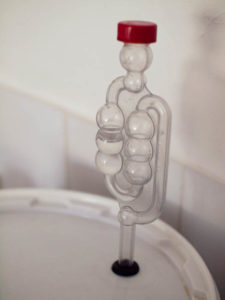Primary and Secondary Fermentation
The fermentation of your beer is one of the most important parts of the brewing process. It may seem like the part where you don’t really do much but it is also the stage of the process where many things can influence the taste of the finished beer, so what exactly is happening during fermentation.
Lag Phase
After pitching the yeast the first thing they do is adapt to their new environment and begin to reproduce and growing at a high rate. To aid this growth phase nutrients in the wort and any available oxygen are utilised by the yeast cells. This lag time for the beer is a critical point during fermentation, the yeast need to produce enough cells to ferment the beer fully without leaving any residual sugars unfermented. At the same time the wort is at its most susceptible to bacterial infection that could ruin the batch, this is why making sure everything is clean and sanitised is vitally important. The only thing we want to thrive in the beer is the yeast we the brewers select.
This lag phase can last anywhere between 12 – 48 hours, generally speaking the shorter the time the better. The next phase of fermentation is the primary phase.
After the lag phase the yeast should now be at a point where they have reproduced and exhausted all the oxygen available, so they begin to consume sugar as a means of energy. This primary phase is where the majority of the sugars in the beer are converted to alcohol and carbon dioxide.
Primary fermentation is easy to identify because the beer visually transforms in the fermenter. The vigorous activity by the yeast creates a foamy head on the beer called a krausen which is made up of yeast cells, hop debris and proteins in the wort. Your airlock fitted in the fermenter will be actively bubbling every few seconds and this whole process will last several days before winding down.
At this point the majority of the fermentable sugars present in the wort will have been consumed by the yeast and alcohol will have been produced. Depending on the type of beer this period of primary lasts between 2 and 7 days (lagers take slightly longer up to around 2 weeks). The beer now moves into the next stage of fermentation, Secondary.
Secondary fermentation
Some people prefer the term conditioning phase as when you brew a typical ale there is only a small amount of fermentable material left at this point. During this phase the beer will begin to clear as the yeast cells drop out of suspension and some of the undesirable compounds created during primary fermentation will be cleaned up and the flavours will become rounded and any harsh flavours evened out.
In a lot of brewing texts there is some difference in opinion as to whether this second phase should happen in the same vessel as the primary fermentation. A lot of people use the term secondary fermentation to mean they are transferring the beer to a second fermenting vessel. This has benefits such as helping to get a clearer final beer. However there are only a few particular instances when I think using a second fermenter may be considered so I will list them here:
- When Brewing High Gravity Beers
It takes a lot longer to ferment beers up above 8% abv. This means that after primary fermentation the yeast will settle out, those dead yeast cells and the trub can cause off flavours in the beer. If you rack the beer to a second fermenter you leave all the undesirable material behind and ensure a better beer.
- When Fermenting with Hops, Fruit or Wood
If you are adding anything to the beer I think it’s a good idea to add it after the primary fermentation is over. If you are dry hopping there is no way to sterilise the hops so it’s best to add them after there is alcohol present to minimise risk of infection. The easiest and cleanest way to introduce hops or fruit is to put them in the secondary vessel and syphon the beer on them. This means they aren’t going to get caught up in the trub and make the process difficult and messy later on.
If you are using fruit or wood chips you might want to keep them in the beer for longer than 2-3 weeks so using a second fermenter will reduce the risk of any off flavours from the the beer sitting on the trub too long.
- When You are Brewing Certain Styles
If you are brewing a lager generally it will be fermenting for longer so it’s a good idea to get the beer off the trub.
Is It Necessary to Use a Secondary Fermenting Vessel?
If you are brewing an ale then I would say no, not really.
Primary fermentation and conditioning will be over with 2-3 weeks so you aren’t going to get any off flavours and by moving to secondary you have a small risk of oxidising the beer or getting an infection. Unless I am leaving the beer in the fermenter for long periods or doing one of the things listed above then I always just bottle or keg without a second vessel being used.
Primary fermentation and secondary (conditioning) will be over within 2-3 weeks, then it’s time to bottle the beer or keg it.

